
Annual Performance Statement 2024
Download a PDF of the full report or read the full report below
26 April 2024
Introduction and context
Purpose of this statement
As required under section 5DB of the Infrastructure Australia Act 2008 (Cth) (IA Act), Infrastructure Australia, during each financial year, must give to the Minister and table in both Houses of Parliament:
- an annual budget statement to inform the annual Commonwealth budget process on infrastructure investment; and
- an annual performance statement on the performance outcomes being achieved by states, territories and local government authorities in relation to the infrastructure investment program and existing project initiatives funded by the Commonwealth.
Context
In 2022, the Australian Government undertook an Independent Review of Infrastructure Australia. Following the release of the Government’s response to the Review, Parliament passed legislative amendments to the IA Act in December 2023. This included the requirement for Infrastructure Australia to produce and publish these annual statements.
With the passage of the amendments occurring late in 2023, the Annual Performance Statement 2024 was developed using readily available data within the time available.
The Annual Performance Statement 2024
This first edition of the Annual Performance Statement sets out Infrastructure Australia’s advice regarding the outcomes being achieved in relation to the Australian Government’s Infrastructure Investment Program (IIP), which funds land
transport projects.
Agreed performance outcomes and measures across the nationally significant infrastructure sectors within Infrastructure Australia’s remit are yet to be determined. As a result, this year’s Performance Statement focusses on the IIP and its alignment to the outcomes sought through the Government’s Infrastructure Policy Statement (IPS).
Infrastructure Australia will work with the Australian Government to agree an approach to reporting in future editions of the Annual Performance Statement, including considering the establishment of performance outcomes and measures for the sectors in Infrastructure Australia’s remit.
The Statement also includes market capacity analysis and trends and insights gleaned from Infrastructure Australia’s evaluation of business cases for nationally significant infrastructure for consideration in the development of future infrastructure proposals.
Australia’s Infrastructure Market Capacity
Infrastructure Australia’s 2023 Market Capacity Report found that Australia’s major public infrastructure pipeline had slightly smoothed over the preceding 12 months, with projected expenditure more evenly distributed over the
forward estimates.
In November 2023, the Australian Government announced changes to projects funded through one of its programs feeding into the public infrastructure pipeline, the IIP. The changes included allocation of additional funds, removal of funds, and deferral of funds. Infrastructure Australia has undertaken analysis to determine the effects of these changes on the public infrastructure pipeline.
Infrastructure Australia’s analysis below assumes a conservative position that all defunded projects are not going ahead, with this scenario resulting in a 2.3% reduction in the 5-year public infrastructure demand pipeline. However, in reality, some projects may still proceed at the discretion of each respective state and territory, without an Australian Government funding contribution.
Furthermore, the Australian Government’s cashflow contribution to the 5-year public infrastructure demand pipeline via the IIP is approximately 20%, with the remainder mostly comprising state and territory funding, including many projects which are not receiving Australian Government funding. Therefore, the impact of the announced changes to the IIP on public infrastructure construction capacity constraints will be properly understood after infrastructure pipelines from each state and territory have been updated.
| Scenario | 5-year total demand | % Change from baseline |
| 2023 Public infrastructure pipeline | $282.8 billion | baseline |
| with projects scaled by additional funds | $286.1 billion | 1.2% |
| with defunded projects removed | $276.4 billion | -2.3% |
| Pipeline with net IIP funding changes | $279.8 billion | -1.1% |
Under the assumption that all defunded projects will be cancelled, the revised IIP will slightly relieve the labour shortage in coming years. Labour demand for publicly funded projects will reduce by up to 8,000 full-time equivalents per month, representing up to 2% of current labour demand in 2024-25.
Figure 1: Public infrastructure workforce demand

The announced changes also reduces quarried materials demanded, although the effect of this impact will be in later years as its impact takes effect during the construction phase of project delivery. By 2027-28, annual quarry demand in the public pipeline drops by up to 3%, or up to 1.2 million tonnes per year.
Figure 2: Public infrastructure quarried material demand

Global supply chain pressures have eased, with steady improvements in international production, trade, and transport measures compared with 12 months ago. However, demand still significantly outweighs supply, and productivity for the construction sector remains stagnant compared to other industries.
The analysis above demonstrates that revisions of proposed infrastructure pipelines can have material effects on managing market capacity and supporting performance of the infrastructure construction market.
As part of normal yearly budget processes, Infrastructure Australia recommends governments carefully review their project pipelines, both within and across sectors. These reviews should ensure that demand is carefully matched to supply of plant, labour, equipment and material. This will ensure that governments are not competing against each other for scarce resources and provide a checkpoint for projects’ progress.
The Infrastructure Investment Program (IIP)
The Australian Government’s over $120 billion infrastructure pipeline aims to improve the productivity of Australia’s land transport networks by working with every state and territory to build much-needed infrastructure across a number of individual funding programs.1 The infrastructure pipeline comprises the IIP, financial assistance grants, equity, and other infrastructure investments.
Infrastructure Investment Program objective
The IIP, which comprises the majority of the infrastructure pipeline’s funding, ‘supports economic growth, makes travel safer, increases transport access and supports regional development. It increases the efficiency, productivity, sustainability and safety of Australia’s land transport infrastructure through programs and policy to improve connectivity for communities and freight.’2
Recent Reforms
The Australian Government recently undertook two significant reviews relating to its infrastructure investment – the Independent Strategic Review of the IIP, and the Independent Review of the National Partnership Agreement on Land Transport Infrastructure Projects.
The reviews recommended wide-ranging reforms to the Government’s infrastructure investments, including but not limited to:
- Implementing a long-term, integrated approach to planning, incorporating the IPS
- Developing a comprehensive outcomes and performance framework
- Taking a risk-based approach to project oversight
- Reviewing the National Land Transport Act 2014 and maintenance funding
- Improving data and systems practices
Infrastructure Australia supports the recommendations from both reviews. It is anticipated that as the reviews’ recommendations are implemented, such as those related to improved performance reporting, additional data will be available to support future performance statements.
IIP context
Within the IIP, the breakdown between the funding parties comprises 60% from the Australian Government, with 39% from state and territory governments, and the remaining 1% coming from other sources, such as local governments.i
Funding Split
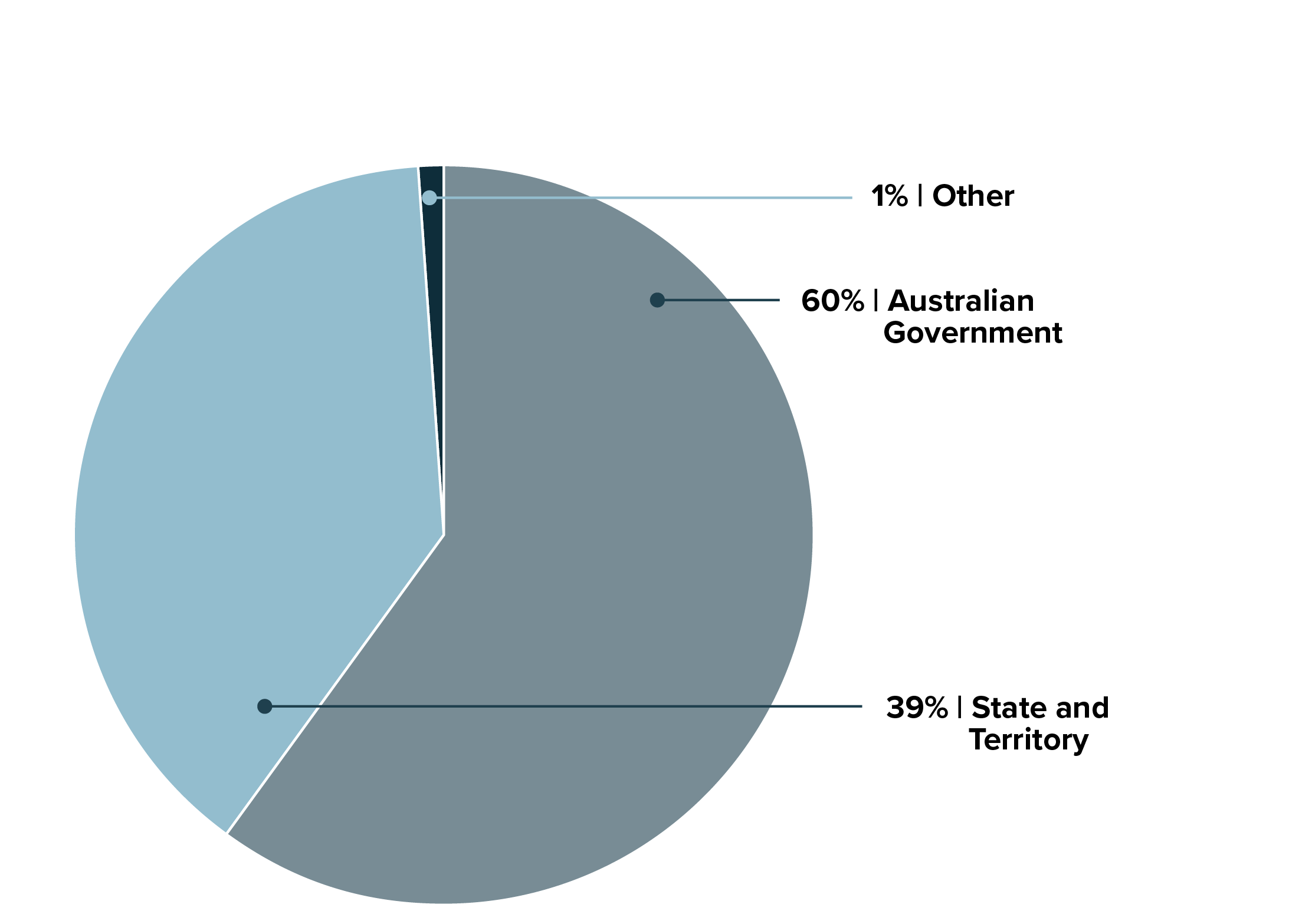
i. Figures provided by the Department of Infrastructure, Transport, Regional Development, Communications and the Arts. Includes IIP major projects with funding from 2023-34 (excluding unallocated funding) and excluding sub-programs of Black Spot, Heavy Vehicle Safety and Productivity, Bridges Renewal, and Roads to Recovery.
In terms of the modal breakdown of its investment, 69% of Australian Government funding (2023-24 to 2032-33) in the IIP is committed to road projects, with 25% allocated to rail infrastructure. The remaining 6% of funding is committed to the remainder of the IIP.ii Australian Government investment in infrastructure also occurs outside of the IIP on both road and rail infrastructure, for example Inland Rail.
ii. Figures provided by the Department of Infrastructure, Transport, Regional Development, Communications and the Arts. Includes unallocated funding to applicable states. Also includes national unallocated funding which is held against the road allocation.
Australian Government Investment Allocation by Mode
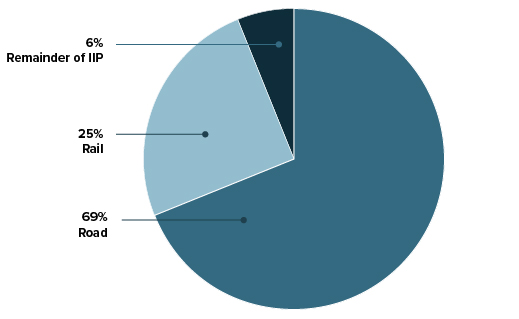
The Infrastructure Policy Statement (IPS)
Future investments in the IIP will be guided by the Government’s IPS, which was released in late 2023. The IPS, in addition to defining nationally significant infrastructure, identifies three strategic themes that encapsulate the benefits the Government seeks from its infrastructure investments:
- Productivity and resilience – seeking to improve the ability of Australians to move around and between cities, towns and regions, and to strengthen the resilience and efficiency of transport networks.
- Liveability – connecting people with where they live and work, supporting vulnerable communities, providing better opportunities in lower socioeconomic areas and improving the safety of the nation’s transport networks.
- Sustainability – reducing transport and infrastructure emissions for private users and freight movements through design, construction and operation.
Performance of the IIP against the IPS
Infrastructure Australia undertook analysis of a subset of projects within the IIP to understand the alignment of the Government’s existing IIP investments with the policy outcomes in the IPS. It should be noted that for most, if not all of the projects we analysed, the IPS was not in place at the time funding decisions were made. The purpose of this analysis is therefore to demonstrate where governments may wish to focus future decision-making to help achieve the IPS outcomes.
What Infrastructure Australia assessed
The purpose of Infrastructure Australia’s analysis was two-fold and aimed at understanding projects’:
- expected economic return (based on the business case), and
- alignment of the projects’ benefits with the Government’s IPS.
The analysis is based on Infrastructure Australia’s previous evaluations of project business cases. The business case data was developed by the relevant state or territory governments and provides a ‘before construction’ view of anticipated project benefits, as opposed to realised ‘after construction’ benefits. The analysis therefore gives an indication of the expected benefits of projects at or around the time decisions to fund them were made.
The data was considered current at the time Infrastructure Australia evaluated the business cases and does not account for any subsequent cost increases or scope changes. The data represents Infrastructure Australia’s position on the expected project benefits at the time the business case
was evaluated.
The analysis is limited to projects within the IIP that have:
- An Australian Government commitment of $250 million or more, and
- An Infrastructure Australia evaluation of the business case.
Filtering out program and unallocated funding, 44 projects were deemed in scope and analysed.iii As they comprise significant projects within the IIP, this subset of projects provides a good foundation for analysis.
To undertake this work, Infrastructure Australia sourced data from the business case evaluation summaries (available on the Infrastructure Australia website) and analysed this data against the themes in the IPS.
iii. 17 rail & public transport projects; 27 road projects

Infrastructure Australia’s findings
Overall, the projects analysed demonstrate a positive economic return
According to business case data, Infrastructure Australia found that the analysed projects were expected to deliver a positive economic return, with a forecast return of $1.17 of economic value for every $1 of infrastructure spending nationally.iv Rail and public transport projects were found to have slightly lower economic returns, $1.13 for every $1 invested, compared to roads, $1.32 of economic return. This is because road business cases count higher productivity benefits, which are a greater share of overall benefits, while rail and public transport projects offer greater liveability and sustainability benefits.
iv. The economic return is the average of projects’ core Benefit Cost Ratio results, excluding wider economic benefits, weighted by the relative value of projects to represent a true economic return.
It is important to note that the economic analysis of a project is only one of several key inputs into Infrastructure Australia’s evaluations. Other significant and important considerations when making infrastructure investment evaluations include the proposal’s:
- Strategic fit – is there a clear rationale for the proposal?
- Societal impact – what is the proposal’s value to society, the environment and the economy?
- Deliverability – can the proposal be delivered successfully?
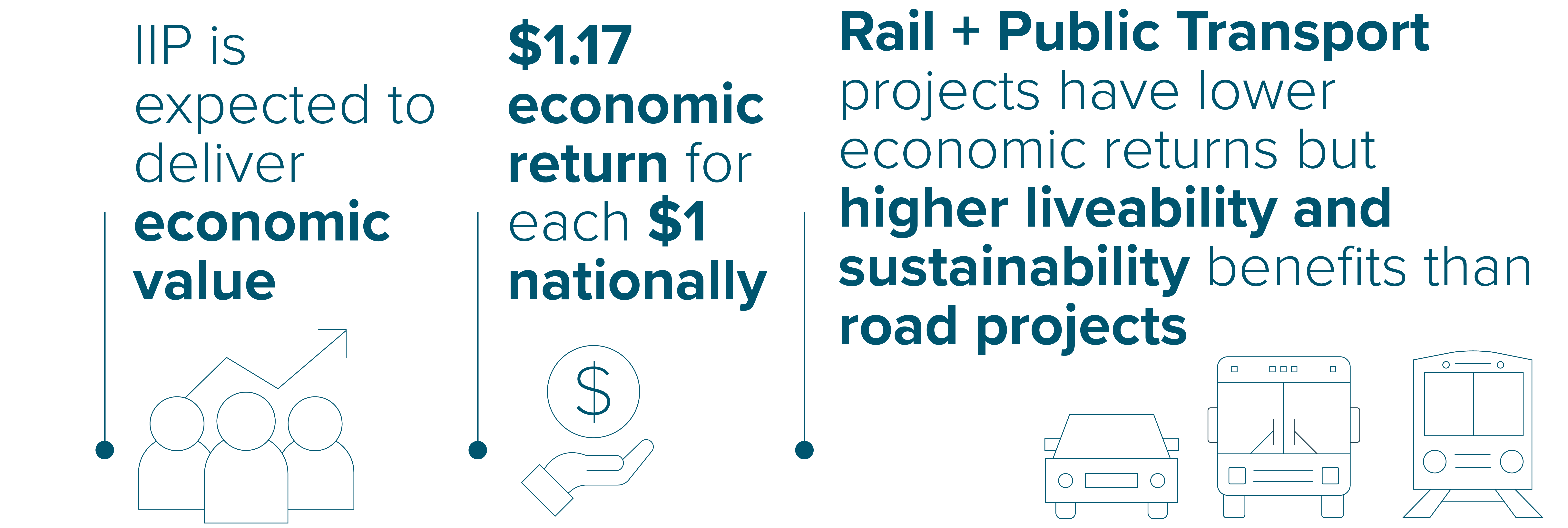
Productivity comprises almost three quarters of project benefits
Infrastructure Australia’s analysis found that productivity is the main driver of project benefits in the projects analysed, comprising 73% of project benefits.
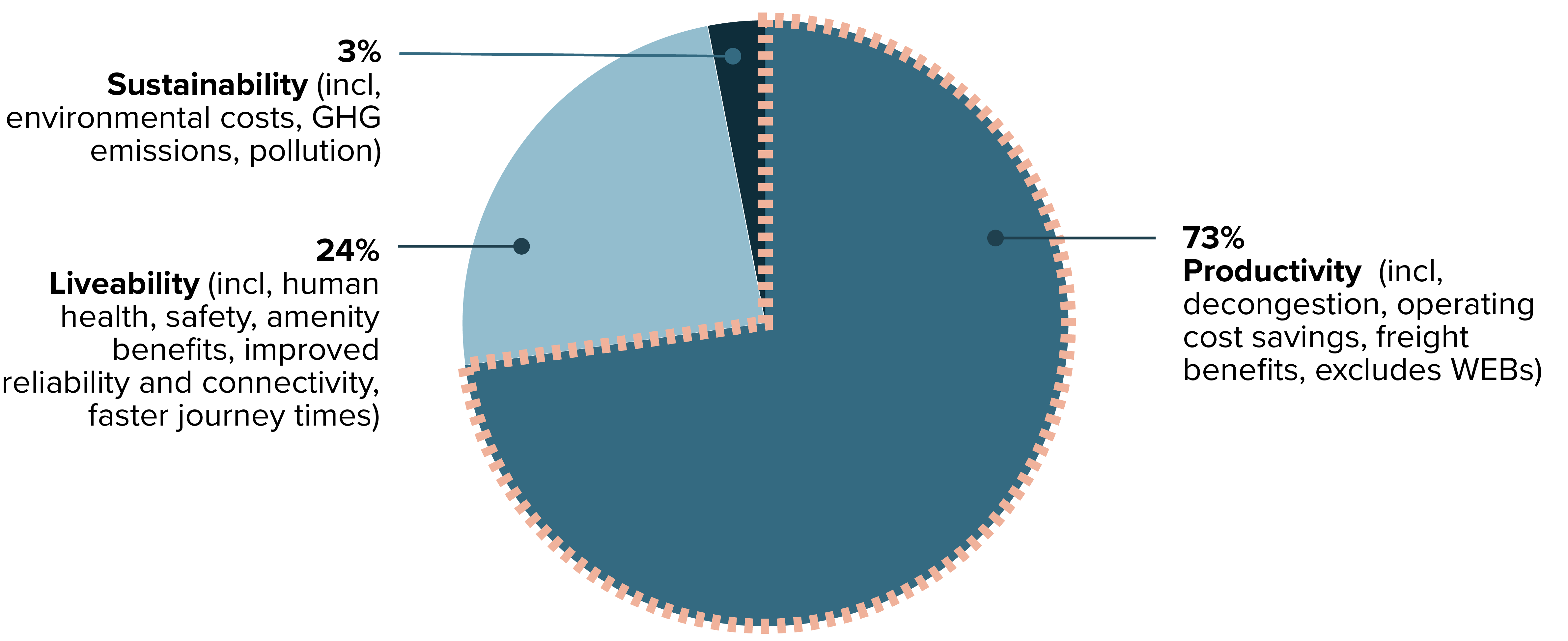
Rail and Public Transport projects demonstrate higher liveability and sustainability benefits
Across the projects, liveability comprised 24% and sustainability 3% of project benefits. Rail and public transport projects demonstrate higher liveability and sustainability benefits than road projects, representing 64% of projected liveability benefits and 65% of sustainability benefits, despite representing only 46% of the projected cost of the analysed projects.
Rail and Public Transport vs Road benefits
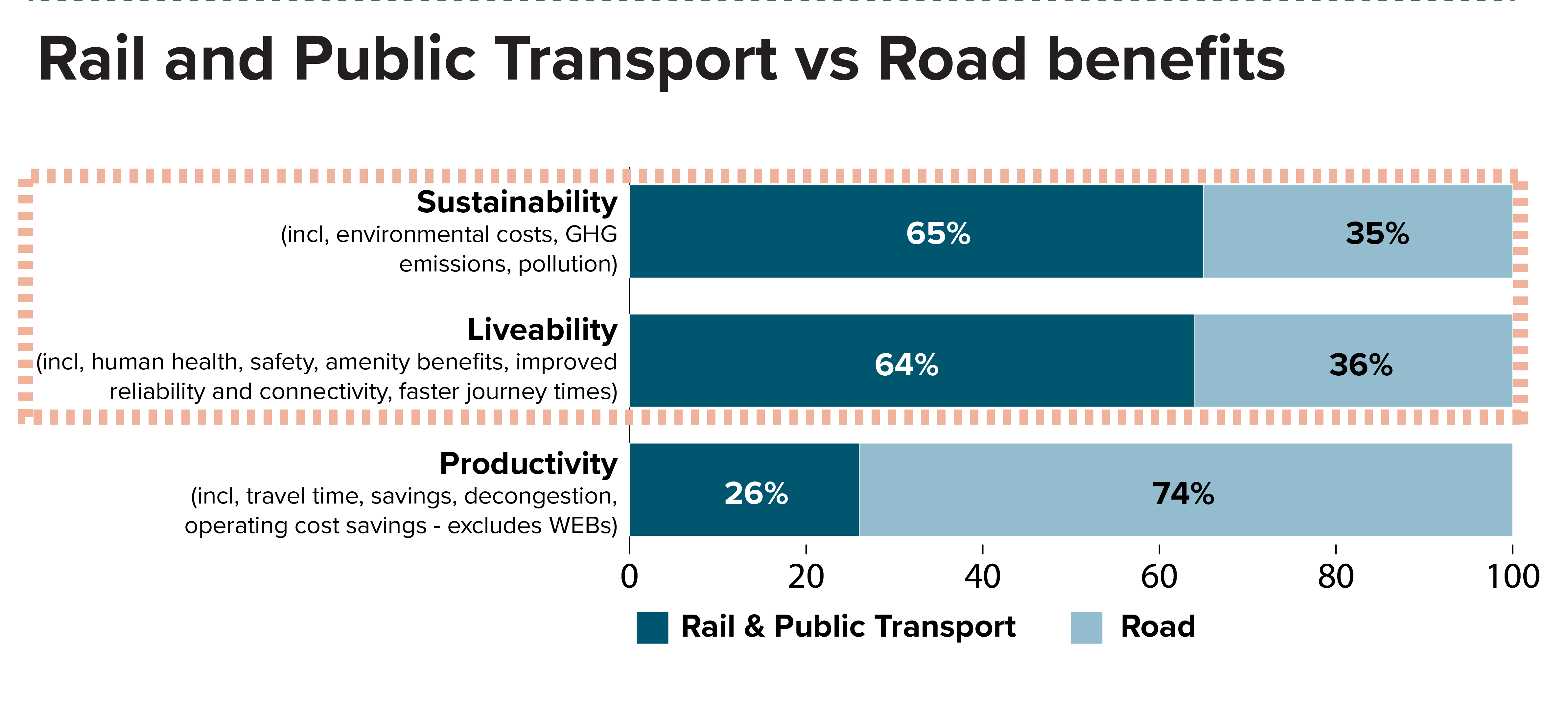
Improving the consideration of sustainability benefits in business cases needs urgent attention
Sustainability benefits comprise 3% of project benefits, however this is not a true representation of the potential sustainability benefits of the projects analysed because:
- Typically, there is a low quality of sustainability evidence provided in business cases – particularly as business cases often do not describe a project’s:
- emission reduction targets
- mitigation, avoidance and/or offset measures, and
- intentions to use recycled/ low emissions building materials.
- Sustainability has not necessarily been a core objective of the projects (outcomes are usually focused on transport access, connectivity and place-making).
- Greenhouse gas (GHG) emissions baseline and savings in construction and operations, including embodied emissions, are often not included in cost-benefit analysis (CBA).
- Sustainability issues, such as recycled content or third-party sustainability certification requirements, are typically only considered later in the project development lifecycle (usually in procurement
or construction).
Improvements to the quality and detail of sustainability data provided in business cases are required to accurately understand the sustainability benefits of proposals. This is discussed further under Trend 4 – Inconsistent assessment of sustainability and resilience, in the Trends and Insights section below.
Business case trends & insights
Based on our experience evaluating business cases, we have identified six trends in project planning processes where there are opportunities to improve and support future Australian Government infrastructure investments.

Trend 1
Trend 1: Project scopes are increasing
Projects are growing in scope, scale, complexity and cost. Not only are projects getting bigger, the number of megaprojects (valued at over $1 billion) as a proportion of state and territory infrastructure pipelines is also increasing. This is backed up by Infrastructure Australia’s 2023 Market Capacity data, which shows the rapid increase in infrastructure pipelines over recent years, and jurisdictional reports showing the growing average size of projects.4,5,6,7,8
Across jurisdictions, project reporting shows that high value projects are more at risk of failing cost and time indicators, compared to other, lower value projects.7,5,9 Megaprojects are inherently more complex and riskier,10 and a growing national pipeline of megaprojects puts pressure on public and private sector delivery capability – heightening risks of cost overruns and schedule delays.
Infrastructure Australia’s experience in evaluating business cases has also identified that as well as a rising number of megaprojects, increasingly large projects are incorporating additional scope that is unrelated to the core problem the project was intended to solve. This risks eroding value for money where the planning context and strategic rationale for the additional scope is not robustly justified – for example, active transport add-ons to motorway investments that are not well planned, not sufficiently interconnected with local pedestrian and bike networks and/or are not demonstrated to have demand.
Ensuring that project scopes, and any subsequent changes, are consistent with the original investment objective is critical to achieving the performance objectives of the IIP and the IPS.
Trend 2
Trend 2: Lack of strategic planning
Although jurisdictions have infrastructure strategies and long-term infrastructure pipelines, business cases for individual projects often do not consider the impact of project delivery and staging on that state or territory’s infrastructure program as a whole.
There is a disconnect between strategy and delivery, with individual project delivery decisions and implications not being considered in the context of the infrastructure pipeline, such that sequencing and coordination of individual projects is not maximising fiscal, delivery and investment outcomes regionally, state and nation-wide.
Infrastructure Australia’s 2023 Market Capacity data demonstrates that one in three megaprojects are planned to be delivered within 50 kilometres of at least one other megaproject. The density of nearby megaprojects is likely to result in hyper-localised shortages and supply risks that require integrated planning. This analysis incorporates the private and public project pipeline, demonstrating that a market-wide lens needs to be taken to understand demand and supply chain constraints.
Corridor planning and medium-term delivery planning are needed so that project-level outcomes and program-wide objectives can be better realised. Initiatives by the Australian Government to encourage a corridor approach to project planning and 10-year infrastructure plans by jurisdictions for land transport infrastructure will help. Ensuring alignment of business cases with these strategies is critical for reducing competition between interrelated projects within the same corridor and highlighting the trade-offs between market capacity and delivery pipeline. It can also achieve benefits from the infrastructure sooner, as well as minimising disruption due to uncoordinated processes leading to prolonged delivery and interface risks. Ensuring business cases choose an appropriate base case that includes committed and funded projects will highlight whether projects target the same beneficiaries and benefits.
To reduce cost pressures on projects and ensure outcomes are achieved, investment decisions should consider broader market capacity pressures and the interrelationship between projects, rather than considering each project in isolation.
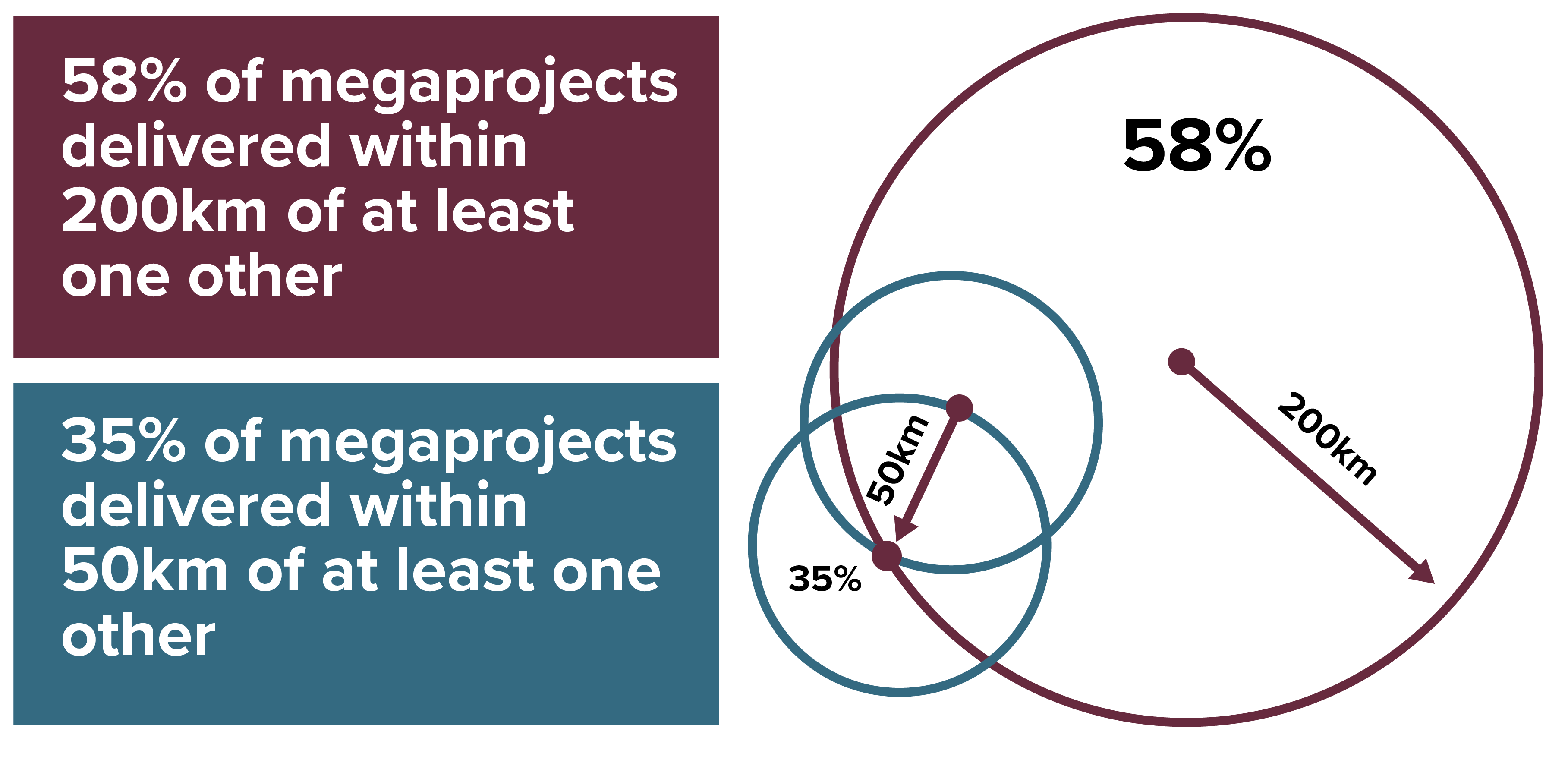
Trend 3
Trend 3: Business cases only assess one option
In an analysis of 77 business cases submitted to Infrastructure Australia, 53% had only considered one option in detail. The Infrastructure Australia Assessment Framework (IAAF), which is consistent with the majority of national, state and territory guidelines for business case development, recommends at least two options are assessed in a business case. At least two feasible options for detailed development in the business case enables a rigorous and defensible analysis to determine the most appropriate investment response.
Number of options assessed in business cases
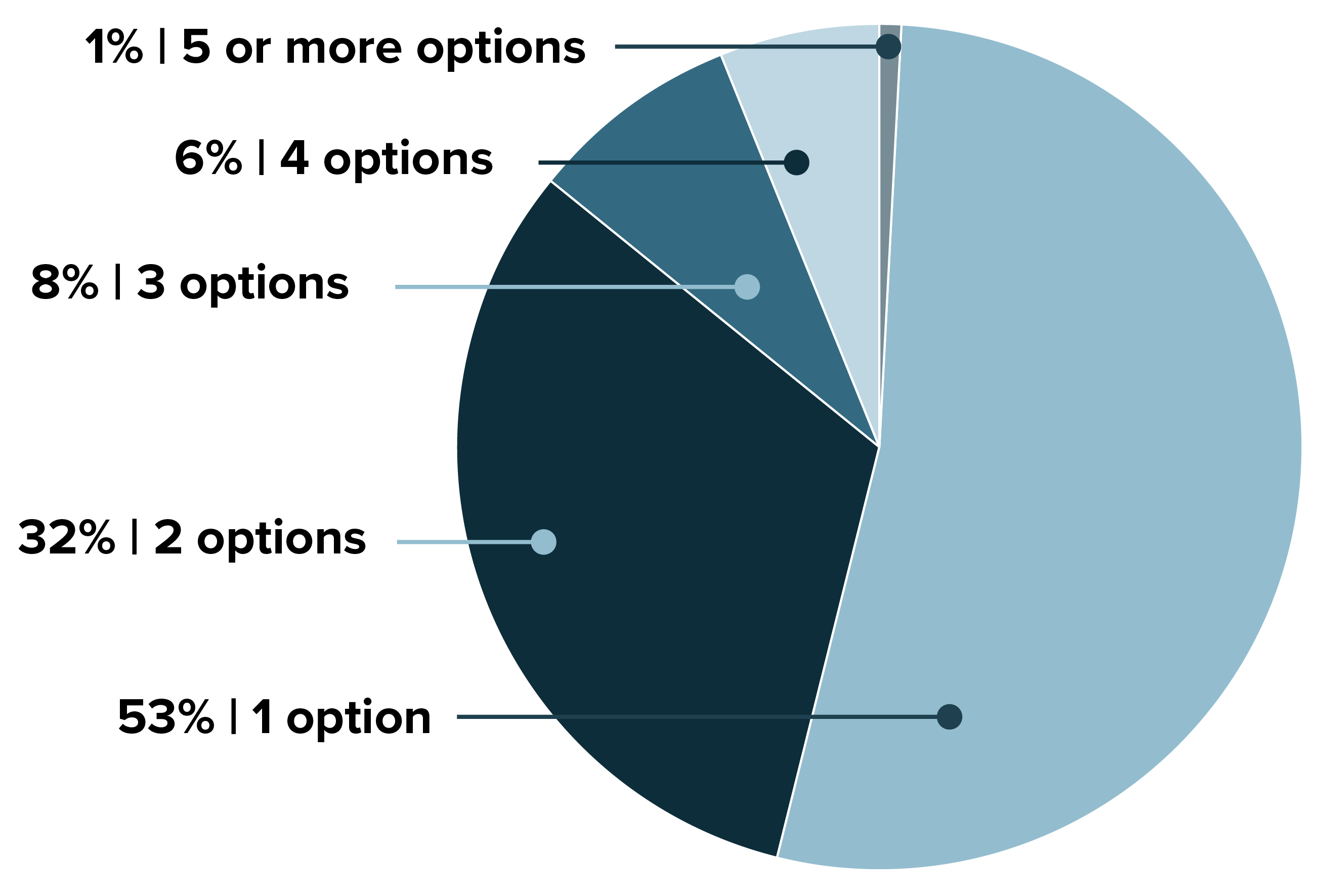
Evidence from some states and territories likewise indicates insufficient consideration and analysis of alternative investment options in the development phase of projects. For instance, project assurance reviews in NSW conducted in the 2021 and 2022 financial years identified ‘Quality of business cases’ as the worst area of performance among 6 critical recommendation themes. These reviews also highlighted deficiencies in the identification of alternative investment options (including consideration of both infrastructure and non-infrastructure interventions) and associated analysis of their respective benefits.9
Similar issues were identified in a Victorian review of major transport project business cases, which concluded that – while the development of project business cases was generally consistent with relevant government requirements and guidelines – the majority of reviewed projects did not include sufficient consideration and analysis of alternative investment options and their benefits.7
Another trend Infrastructure Australia sees in ‘options analysis’ (Stage 2 of Infrastructure Australia’s assessment process) and ‘business case’ (Stage 3 of Infrastructure Australia’s assessment process) submissions is that non-build options such as regulatory or technological solutions are often discarded early in the development phase. This leads to a preference for building new infrastructure rather than using what already exists more efficiently. Appropriately considering retrofits and/or demand management solutions can avoid GHG emissions during construction, environmental impacts, and community and business disruption costs. It may also lead to lower-cost solutions with smaller market capacity impacts.
Assessing more than one option in the detailed business case helps to achieve the most efficient infrastructure investment that bests support Government’s objectives, such as emissions reduction, productivity enhancement or regional connectivity. Considering more than one option increases the transparency of analysis by clearly comparing the societal and sustainability benefits that may be achieved in individual options. For example, an alternative option may be readily delivered using recycled content or a ‘no-frills’ scope that minimises embodied emissions. Regulatory interventions (such as road pricing) might also offer additional benefits such as encouraging public transport use and reduce GHG and noxious vehicle emissions.
Business cases which only assess one option remove government’s ability to properly consider alternatives and determine if the investment is the best use of taxpayer dollars. Often, an expensive ‘megaproject’ is brought forward for investment decision with no alternative, lower-cost options for comparison, which compromises the decision-making process and leads to a less diverse project mix within the investment program overall, thus increasing the program’s size and risk.
Trend 4
Trend 4: Inconsistent assessment of sustainability and resilience
Assessing GHG emissions
In response to changes to the IA Act in September 2022, Infrastructure Australia has developed and published a Guide to assessing greenhouse gas emissions, which sets out Infrastructure Australia’s requirements for project proposal submissions to consider the impact of infrastructure emissions on Australia’s national targets.
Since 2022, Infrastructure Australia has evaluated 14 transport business cases, representing a total outturn cost of $40.5 billion. Until recently, the quality of evidence to support assessment of emissions impacts has been lacking.
While all 14 business cases since 2022 provided evidence that the project reduced GHG emissions due to decreased or improved vehicle travel times or modal shift to rail, only 4 business cases recognised and monetised the disbenefit of increased vehicle GHG emissions from additional (induced) demand. As Infrastructure Australia’s Guide to Assessing GHG Emissions points out, including the positive impact on emissions of travel time savings and decongestion, while ignoring the corresponding negative impact of induced demand on increasing vehicle emissions, misrepresents the sustainability credentials of major infrastructure projects.
In terms of embodied carbon from construction, only 1 business case monetised embodied impacts as part of economic analysis, 6 business cases only qualitatively described them, and 7 omitted embodied impacts altogether. Embodied carbon is important to quantify and include in CBA because it can represent up to 90% of GHG emissions from the construction and operations of transport projects.v,11,12,13 Quantifying embodied carbon in the early stages of project development allows project teams and decision-makers to consider embodied carbon in the scoping phases, and thereby can help to consider lower emitting alternatives or to optimise carbon reduction opportunities through the remainder of project development.
Notably, there is also some variation in the value of carbon used in business cases. Assessing business cases using a standardised national value for carbon ensures that the emissions impact of projects can be compared on a like for like basis by decision-makers. Infrastructure Australia released a Valuing emissions for economic analysis guide in March 2024 which provides national carbon values for use in infrastructure business cases – these values are required to be used in business cases for nationally significant projects seeking Australian Government funding being assessed by Infrastructure Australia.
To achieve the GHG reduction targets set by the Australian Government, governments must consistently and rigorously integrate decarbonisation into infrastructure planning as part of business-as-usual processes.
v. Excluding enabled emissions from downstream users.
Other sustainability considerations
There are examples of good sustainability practices across the infrastructure sector, such as the Victorian Government’s Recycle First Policy and generally a commitment by most states and territories to achieve an Infrastructure Sustainability Ratingvi for their major infrastructure projects. Circular economy policies and third-party accreditation help highlight sustainability opportunities and drive good practices in project delivery. However, mechanisms such as third-party ratings can see sustainability measures considered too late in the project development lifecycle, generally during the procurement/construction phases, with measures being driven by contractor innovation rather than intentional project outcomes.
Recognising opportunities to reduce operational and embodied emissions at the outset and as part of project planning, including assessing emission reductions in options analysis and business cases will ensure decision-makers can make net zero-aligned infrastructure investments. It can also highlight where existing procurement practices and engineering specifications require flexibility to enable the use of low emissions construction materials.
Lastly, the impact of environmental externalities, such as land clearing or tree plantings, which result in negative and positive impacts on biodiversity, as well as environmental costs and offsets, are not usually included in business cases. Although some of these externalities and costs may be small in relation to the project’s overall costs and benefits, proponents should attempt to describe them. Providing transparency of expected environmental impacts qualitatively can highlight opportunities to improve environmental outcomes, such as avoiding clearing remnant vegetation, which may have high conservation, biodiversity or other benefits but are hard to quantitatively assess.
vi. The Infrastructure Sustainability Rating Scheme is a rating system for evaluating economic, social and environmental performance of infrastructure across the planning, design, construction and operational phases of infrastructure assets. See https://www.iscouncil.org/is-ratings/ for more information.
Embedding resilience outcomes
Infrastructure Australia has also identified a need to better consider resilience in infrastructure planning and decision-making, through business case guidelines, capital asset planning and assurance processes.
An agreed methodology and guidance on how to value resilience in decision-making through the infrastructure lifecycle and the development of a nation-wide approach to quantifying risk, costs, benefits and performance of resilience assets and places is needed. This approach should be aligned across jurisdictions, referenced in policies and embedded in assessment frameworks and processes.
The risks posed by increasing extreme weather, mean temperatures, sea level rise and natural disasters (such as flooding and drought) will challenge the resilience of infrastructure built to existing standards and planning. Research has demonstrated that private infrastructure assets could see 27% loss in asset value by 2050 due to climate risks.14 Public infrastructure is similarly exposed – and this poses the risk of disruptions to services on which communities and businesses rely, as well as write-downs of public assets, impacting government balance sheets.
Given a major share of natural disaster costs arise from damage to critical infrastructure, estimates suggest $17 billion (in present value terms) may be required for the direct replacement of essential infrastructure during the period between 2015 and 2050 due to natural disaster damage.15 This does not include costs stemming from service disruption.
Despite an increasing appetite for change, infrastructure is being delivered that is generally not sufficiently resilient to future events, resulting in poor social, economic and environmental outcomes for communities and taxpayers. Governments are at different points in embedding resilience and climate adaptation into their frameworks and there are varying degrees of maturity across infrastructure bodies’ guidance and assurance processes.
It is imperative that projects being considered for development and delivery give regard to the long-term resilience implications of an asset’s operations, location, climate risks and the shocks and stresses that are likely to occur over the course of its lifetime.
Trend 5
Trend 5: Disruption impacts not included in business cases
As the scale and complexity of infrastructure projects grow, delivery schedules are lengthening and the footprint and extent of community impacts are increasing.
Disruption impacts include congestion and service disruptions due to construction, impacts on or access to significant places including aboriginal cultural heritage, and acquisitions of properties and relocation of businesses. The construction footprint of a project is often larger than the area of the asset itself, as land is utilised for workers facilities and equipment and materials staging and storage.
Disruption impacts have important equity considerations that should be carefully considered in the business case. This is because the communities who are impacted during construction may not be the beneficiaries of the project.
There are implicit trade-offs between proposed project benefits and disbenefits and to whom those benefits and disbenefits accrue. Further, short-term disruptions, especially if they are unplanned, can be disastrous for long-term economic benefits.
While some disruptions are unforeseen, many disruptions can be anticipated, and therefore attempting to describe and quantify all disruptions can reduce the probability of unplanned events by highlighting potential mitigants, including further planning, contractual considerations and community engagement.
Analysis of a project’s costs and benefits helps decision makers understand the balance of project (dis)benefits versus costs. Infrastructure Australia’s Assessment Framework recommends that disruption impacts are included in the CBA for projects where these costs are expected to be large. The costs are likely to be significant when building a major transport upgrade (light rail, rail or a major road expansion) through a highly urbanised and developed area.
While CBA describes the balance of costs and (dis)benefits, it does not provide transparency as to whom, when and where (dis)benefits accrue. Equity analysis that maps to whom and where (dis)benefits accrue can provide this transparency. Infrastructure Australia’s Assessment Framework recommends business cases describe and analyse distributional effects, including the scale of those effects at a spatial and temporal level. Maps, diagrams and charts can help illustrate the scale of those effects. State and territory governments should ensure that business case frameworks require disruption impacts in CBA, and distributional impact analysis, particularly for large projects in urban areas.
Trend 6
Trend 6: Lack of rigour in economic analysis
Infrastructure Australia has observed that business cases can rely on cherry-picked assumptions and data to bolster the economic case for projects. In Infrastructure Australia’s analysis of 77 business case evaluations, unrealistic or non-standard modelling inputs/assumptions was the third most identified issue in the assessment of project economic appraisals – being reported in 63% and 78% of road and rail business cases respectively.
Inaccurate assumptions can lead to misleading benefit-cost ratios that are inflated by benefits that may not materialise. Overstating project benefits undermines decision makers’ ability to allocate public resources efficiently and erodes the options analysis process, by preferencing foregone planning outcomes rather than robustly testing options.
Infrastructure Australia’s Assessment Framework stipulates the Australian Transport Assessment and Planning Guidelines16 and/or Austroads assumptions that should be used, to ensure business cases conform to nationally standardised assessment practices. Standardisation provides a common approach to measuring and evaluating projects, supports transparent funding decisions based on a consistent and agreed set of inputs, and enables governments to compare projects’ economic results on a like-for-like basis. As research on major project assessment has found, CBA as a decision tool is only reliable when the inputs and methodologies used are consistent, standardised and reliable.17,18
In Infrastructure Australia’s analysis of business cases, induced demand was cited as an issue in 40% of road and 60% of rail business case evaluations. In a study of a proposed road project in Denmark, researchers showed accounting for induced demand lowers travel time savings, increases negative externalities (e.g. noxious fumes) and results in a considerably lower benefit-cost ratio.19 From a GHG emissions perspective, appropriately accounting for induced demand is critical for identifying the impact of infrastructure proposals on Australia’s emissions targets.
Business cases are often not modelling demand based on post-COVID pandemic changes in travel patterns (including for peak road and public transport demand) or testing model results through post-COVID scenario analyses. Establishing a new normal to reflect post-pandemic office vacancies/journey-to-work patterns is critical to substantiating commuter demand and metropolitan congestion – especially in project base cases. Assuming a return to pre-pandemic levels may still provide a useful baseline against which to test CBA results using a post-COVID status quo.
The impact of overly optimistic demand projections on project economic outcomes is well documented. In a 2018 study, BITRE showed that 60% of the difference between before construction CBA and after construction CBA in 12 road business cases was inaccurate traffic forecasts and methodology errors.20,21
Post completion evaluations to better understand IIP performance
The Australian Government’s response to the Independent review of Infrastructure Australia (2022) recognised the need for post completion reviews to provide greater evidence that projects are achieving their intended outcomes.
Despite broad agreement on the merits of undertaking post completion reviews of infrastructure projects, including the application of lessons learnt and feedback for future investments, Infrastructure Australia’s research and engagement with jurisdictions demonstrates that these reviews are not consistently undertaken and rarely published.22,23
Post completion reviews identify important lessons for governments, communities and industry regarding project successes following project delivery. These reviews determine whether the desired objectives and/or forecast benefits and costs have been realised and can explain the reasons for any differences between the expected and actual outcomes. The aim is to draw appropriate lessons to feed into future infrastructure development and delivery processes.
A component of post completion reviews is after construction cost-benefit analysis, which helps to identify:
- the relationships between inputs, outputs, outcomes and benefits
- the extent of change in schedule, cost, outcomes and benefits
- appropriateness of techniques and assumptions for estimating costs and benefits, including quantitative and qualitative analysis
- where projects have realised additional non-monetised benefits that were unforeseen during planning.
Conducting a cost-benefit analysis after construction can also be used to conduct benchmarking to help improve estimation techniques around costs and risks during planning, or to substantiate forecasts in the business case by comparing a portfolio of projects with similar characteristics. This can help reduce optimism bias during the planning phase of infrastructure projects, ensuring that scheduling, cost and risk of projects is better understood before funding commitments are made.
The analysis and insights provided in this Annual Statement are based on Infrastructure Australia’s evaluation of project business cases because post completion data is not currently available at a national level to assess project performance. Business cases provide a ‘before construction’ perspective of project performance that is based on expectations and probabilities. While useful for making decisions about the use of public resources in the future, this upfront cost-benefit analysis does not provide confidence that the forecasted performance was actually achieved.
Working with Infrastructure Australia and leveraging the well-defined guidance on benefits realisation
and cost review at the jurisdictional level, there is a clear opportunity for all governments to adopt a consistent approach to post completion reviews to gain a better picture of whether the IIP is achieving its intended impact.
References
- Department of Infrastructure, Transport, Regional Development, Communications and the Arts. Available at: https://investment.infrastructure.gov.au/about/national-initiatives
- Department of Infrastructure, Transport, Regional Development, Communications and the Arts, 2023-27 Corporate Plan. Available at: https://www.infrastructure.gov.au/sites/default/files/documents/Secretary%20Approved%20INFRA5702%20Dept%20Corporate%20Plan%202023_04.pdf
- Australian Government. Available at: https://www.infrastructure.gov.au/sites/default/files/documents/infrastructure-policy-statement-20231114.pdf
- Ryan, P. and Duffield, C. 2017, Contractor Performance on Mega Projects–Avoiding the Pitfalls. Mahalingam, A (Ed.) Shealy, T (Ed.) Gil, N (Ed.) pp.1-34. Engineering Project Organization Society. The University of Melbourne, Melbourne, Australia. Available via: http://hdl.handle.net/11343/168246;
- Infrastructure NSW 2023, 2022-23 State of Infrastructure Report, NSW Government. Available via: https://www.infrastructure.nsw.gov.au/investor-assurance/asset-management-assurance/resources/soir/
- NSW Treasury 2019, WestConnex Project Summary 2019. NSW Government, Sydney, Australia. Available via: https://www.treasury.nsw.gov.au/sites/default/files/2020-11/0023_westconnex_summary.pdf
- Victorian Auditor-General’s Office 2023, Major Projects Performance Reporting 2023: Independent assurance report to Parliament 2023-24:9. Available via: https://www.audit.vic.gov.au/sites/default/files/2023-11/20231130_Major-Projects-Performance-Reporting-2023.pdf
- The State of Queensland (Queensland Audit Office) 2023, Major Projects 2023 (Report 7: 2023–24). Available via: https://www.qao.qld.gov.au/sites/default/files/2023-12/Major%20projects%202023%20%28Report%207%20%E2%80%93%202023%E2%80%9324%29.pdf
- Infrastructure NSW 2022, Trends and Insights Report 2022, NSW Government. Available via: https://www.infrastructure.nsw.gov.au/investor-assurance/project-assurance/resources/trends-and-insights/
- Boston Consulting Group (BCG) 2021, International Major Infrastructure Projects Benchmarking Review: Final Report. Prepared by BCG for the Office of Projects Victoria (OPV). Available via: https://content.vic.gov.au/sites/default/files/2023-02/International-Major-Infrastructure-Projects-Benchmarking-Review.pdf
- GHD, 2019, North East Link North East Link Environment Effects Statement Technical report R – Greenhouse gas impact assessment, Prepared for North East Link, Available from: Technical Report R Greenhouse gas (bigbuild.vic.gov.au)
- AECOM, West Gate Tunnel Project – Technical report Q – Greenhouse gas, May 2017.
- Aurecon Jacobs Mott MacDonald in association with Grimshaw Joint Venture (AJM JV) Melbourne Metro Rail Project – Greenhouse Gas Impact Assessment, April 2016.
- Extreme weather could burn investment portfolios by mid-century (theconversation.com), accessed 21 March 2024
- The Australian Transport Assessment and Planning Guidelines outline best practice for transport planning and assessment in Australia. and are available at: https://www.atap.gov.au/
- Australian Business Roundtable for Disaster Resilience & Safer Communities 2016, Building resilient infrastructure, Australian Business Roundtable, http://australianbusinessroundtable.com.au/our-research/resilient-infrastructure-report
- Dobes, Leo, George Argyrous, and Joanne Leung. “Social Cost-benefit Analysis in Australia and New Zealand. The State of Current Practice and What Needs to Be Done”, 2016. https://doi.org/10.26530/oapen_610768
- Vejchodská, Eliška. “Cost-benefit Analysis: Too Often Biased”. E+M Ekonomie a Management 18, no. 4 (2015): 68–77. https://doi.org/10.15240/tul/001/2015-4-005
- Næss, Petter, Morten Skou Nicolaisen, and Arvid Strand. “Traffic forecasts ignoring induced demand: a shaky fundament for cost-benefit analyses.” European Journal of Transport and Infrastructure Research 12.3 (2012): 291-309.
- Bureau of Infrastructure, Transport and Regional Economics (BITRE), 2018, Ex-post Economic Evaluation of National Road Investment Projects – Volume 1 Synthesis Report, Report 145, BITRE, Canberra ACT.
- Bureau of Infrastructure, Transport and Regional Economics (BITRE), 2018, Ex-post Economic Evaluation of National Road Investment Projects – Volume 2 Case Studies, Report 145, BITRE, Canberra ACT.
- Infrastructure Australia, Infrastructure Decision-making Principles (July 2018) https://www.infrastructureaustralia.gov.au/sites/default/files/2019-06/Infrastructure_Decision-Making_Principles.pdf
- Grattan Institute, The rise of megaprojects: counting the costs (November 2020). Available at: https://grattan.edu.au/wp-content/uploads/2020/11/The-Rise-of-Megaprojects-Grattan-Report.pdf